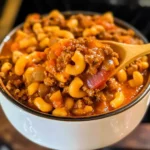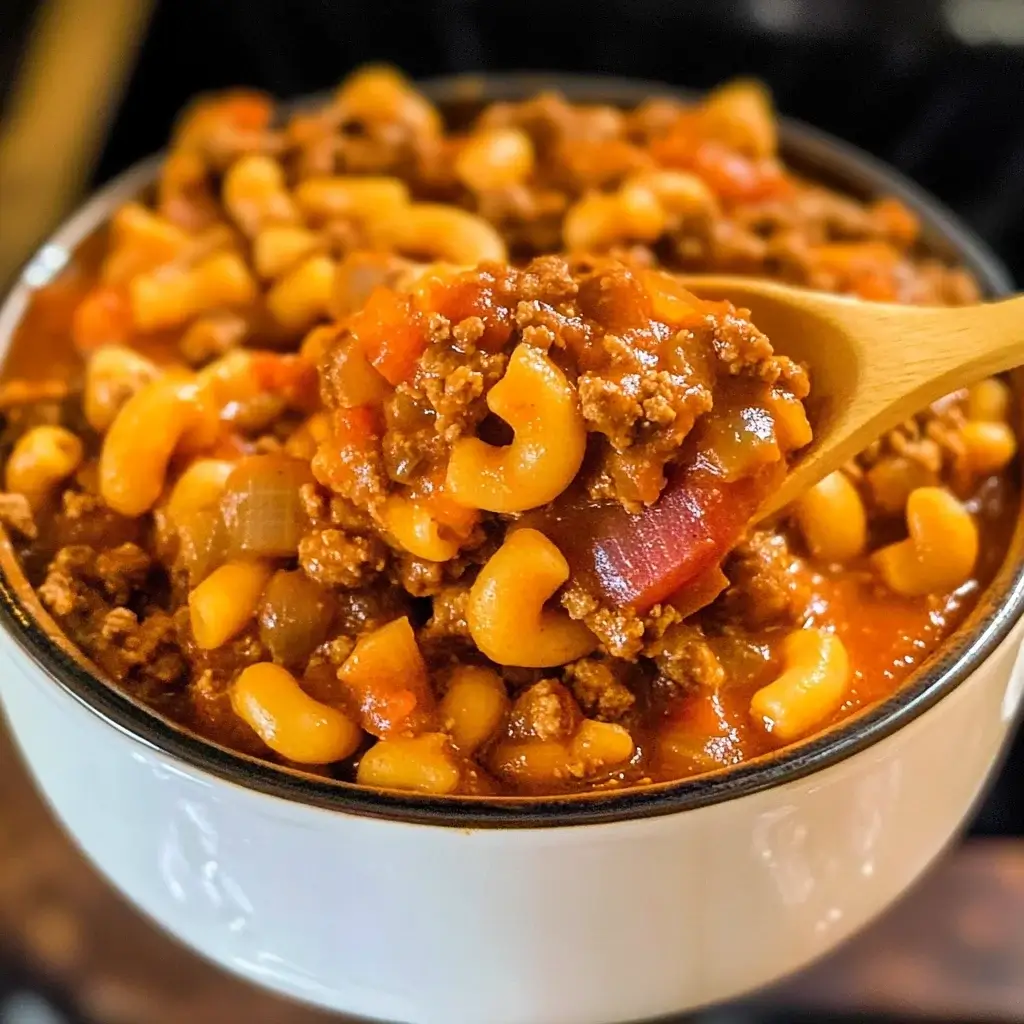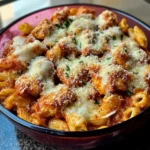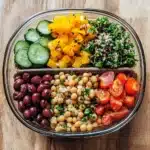My earliest memories of American Goulash are intrinsically linked to cozy weeknights and the comforting aroma that would fill our entire house. My mom wasn’t a fancy cook, but her goulash was legendary in our family. It wasn’t the paprika-rich Hungarian version, but a hearty, tomatoey, beef-and-macaroni masterpiece that felt like a warm hug in a bowl. She’d brown the beef and onions, letting them sizzle and caramelize, then stir in the tomatoes, spices, and finally, the elbow macaroni that would plump up perfectly in the savory sauce. The anticipation was almost as good as the first bite! When I started my own family, it was one of the first “comfort food” recipes I wanted to perfect. My husband, who grew up on a slightly different version, was an easy convert. And my kids? They gobble it up every single time, their happy, sauce-stained faces a testament to its enduring appeal. It’s simple, unpretentious, and utterly delicious – a true family favorite that brings back a flood of wonderful memories with every spoonful.
American Goulash: The Ultimate Comfort Food Classic
American Goulash, a beloved dish gracing family dinner tables for generations, is the epitome of hearty, budget-friendly comfort food. Distinct from its Hungarian namesake, which is typically a stew rich in paprika and often made with chunks of beef, American Goulash is a simpler, more streamlined affair. It’s a one-pot wonder usually featuring ground beef, elbow macaroni, tomatoes, and a savory blend of seasonings, all simmered together until the flavors meld into a delicious, satisfying meal. Often referred to as “American Chop Suey” (especially in New England), “Slumgullion,” or simply “Macaroni and Beef,” this dish is cherished for its ease of preparation, crowd-pleasing nature, and the nostalgic warmth it brings.
Why American Goulash Reigns Supreme in Comfort Cooking
There are countless reasons why American Goulash has remained a family favorite for so long:
- Incredibly Easy to Make: It’s a straightforward recipe, often made in one pot, making it perfect for busy weeknights.
- Budget-Friendly: Utilizing common and affordable ingredients like ground beef, pasta, and canned tomatoes, it’s an economical way to feed a family.
- Crowd-Pleaser: Its savory, familiar flavors appeal to both kids and adults alike. It’s a dish that rarely sees leftovers.
- Highly Customizable: While there’s a basic formula, American Goulash is incredibly adaptable. You can easily add extra vegetables, switch up the spices, or use different types of pasta.
- One-Pot Meal (Often): Many versions allow the pasta to cook directly in the sauce, minimizing cleanup – a huge bonus!
- Hearty and Satisfying: The combination of protein, carbohydrates, and a rich sauce makes it a truly filling and comforting meal, especially on a chilly day.
- Nostalgic Appeal: For many, American Goulash evokes fond childhood memories and the taste of home.
Key Ingredients for a Classic American Goulash
While variations abound, a classic American Goulash typically includes these core components:
- Ground Beef: 1 to 1.5 lbs. Lean ground beef (80/20 or 85/15) works well, providing good flavor. You can also use ground turkey or a mix.
- Elbow Macaroni: 1 to 1.5 cups (8-12 oz) uncooked. This is the traditional pasta choice, but other small pasta shapes like shells, rotini, or ditalini can also be used.
- Onion: 1 large, chopped. Yellow or white onions are standard.
- Bell Pepper (Optional but Common): 1 green bell pepper, chopped. Some recipes also include red or yellow bell peppers for color and sweetness.
- Garlic: 2-4 cloves, minced. Adjust to your preference.
- Tomatoes: This is a key component, and various forms can be used:
- 1 (28-ounce) can diced or crushed tomatoes, undrained.
- 1 (15-ounce) can tomato sauce.
- 2-4 tablespoons tomato paste (for concentrated flavor).
- Broth or Water: 1-3 cups beef broth, chicken broth, or water. The amount will depend on whether you cook the pasta directly in the sauce.
- Seasonings:
- 1-2 teaspoons Italian seasoning (or a mix of dried oregano, basil, thyme).
- 1 teaspoon paprika (sweet or smoked, not Hungarian hot paprika unless desired).
- ½ – 1 teaspoon garlic powder (optional, for extra garlic flavor).
- ½ – 1 teaspoon onion powder (optional).
- Salt and freshly ground black pepper to taste.
- Oil or Fat: 1-2 tablespoons olive oil or vegetable oil for browning the beef and sautéing vegetables.
- Optional Enhancements:
- 1-2 tablespoons Worcestershire sauce for umami depth.
- 1-2 bay leaves, removed before serving.
- A pinch of red pepper flakes for a touch of heat.
- Shredded cheddar cheese or Parmesan cheese for topping (often stirred in or sprinkled on top before serving).
The Perfect American Goulash Recipe: A Step-by-Step Guide
This recipe focuses on the classic one-pot method where the macaroni cooks directly in the sauce, absorbing all the delicious flavors.
Ingredients:
- 1.5 lbs lean ground beef (80/20 or 85/15)
- 1 large yellow onion, chopped
- 1 green bell pepper, chopped (optional)
- 3 cloves garlic, minced
- 1 (28-ounce) can diced tomatoes, undrained
- 1 (15-ounce) can tomato sauce
- 2 tablespoons tomato paste
- 2 cups beef broth (plus more if needed)
- 1.5 cups (approx. 8-10 oz) uncooked elbow macaroni
- 1 tablespoon Worcestershire sauce
- 1 ½ teaspoons Italian seasoning
- 1 teaspoon paprika (sweet or smoked)
- ½ teaspoon salt (or to taste, adjust based on broth saltiness)
- ¼ teaspoon black pepper (or to taste)
- 1-2 bay leaves (optional)
- 1 cup shredded cheddar cheese (optional, for topping)
- Olive oil or vegetable oil (if needed, for browning beef)
Instructions: Creating Your Pot of Comfort
- Brown the Ground Beef:
- In a large pot or Dutch oven, heat a tablespoon of olive oil over medium-high heat if your ground beef is very lean. If using 80/20 beef, you may not need additional oil.
- Add the ground beef to the pot. Cook, breaking it apart with a spoon, until it’s nicely browned, about 7-10 minutes.
- Drain off any excess fat from the pot.
- Sauté Aromatics:
- Add the chopped onion and bell pepper (if using) to the pot with the browned beef. Cook, stirring occasionally, for 5-7 minutes, or until the vegetables have softened.
- Stir in the minced garlic and cook for another 1-2 minutes until fragrant.
- Build the Sauce Base:
- Stir in the tomato paste and cook for 1-2 minutes, allowing it to caramelize slightly. This deepens the tomato flavor.
- Add the diced tomatoes (undrained), tomato sauce, beef broth, Worcestershire sauce, Italian seasoning, paprika, salt, pepper, and bay leaves (if using). Stir everything together well to combine.
- Simmer the Sauce:
- Bring the sauce mixture to a gentle simmer. Reduce the heat to low, cover the pot, and let it simmer for at least 15-20 minutes to allow the flavors to meld. This step is crucial for developing a rich taste. For even deeper flavor, you can simmer for up to an hour if time permits, adding more broth if it becomes too thick.
- Cook the Macaroni:
- Stir the uncooked elbow macaroni directly into the simmering sauce. Ensure the macaroni is mostly submerged in liquid. If it seems too dry, add another ½ to 1 cup of beef broth or water. The macaroni will absorb liquid as it cooks.
- Bring the mixture back to a gentle simmer. Cover the pot again and cook for 12-18 minutes, or until the macaroni is tender (al dente or to your liking). Stir occasionally (every 5 minutes or so) to prevent the macaroni from sticking to the bottom of the pot and to ensure even cooking.
- Finish and Serve:
- Once the macaroni is cooked through and the sauce has thickened nicely, remove the pot from the heat. Remove and discard the bay leaves.
- Taste the goulash and adjust seasonings as needed (more salt, pepper, or even a pinch of sugar if the tomatoes are too acidic).
- If using, stir in about half of the shredded cheddar cheese until melted.
- Serve hot, garnished with the remaining shredded cheddar cheese and perhaps some chopped fresh parsley for color.
Nutrition Facts (Approximate)
- Servings: 6-8 generous servings
- Calories per serving (approximate, based on 6 servings, without cheese topping): 400-550 calories
Disclaimer: Nutritional information is an estimate and can vary significantly based on specific ingredients used (e.g., fat content of meat, type and amount of pasta, brand of canned goods), and precise portion sizes. For exact nutritional data, use an online calculator with your specific ingredients.
Preparation Time
- Active Preparation Time (Chopping, Browning): 20-25 minutes
- Simmering Time (Sauce + Pasta): 30-40 minutes (can be longer for deeper flavor)
- Total Time: Approximately 50-65 minutes
How to Serve Your Delicious American Goulash
American Goulash is a hearty meal in itself, but here are some serving suggestions:
- Classic Bowl:
- Serve generously in bowls, topped with extra shredded cheddar or Parmesan cheese.
- With Bread:
- A side of crusty bread, garlic bread, or soft dinner rolls is perfect for mopping up the delicious sauce.
- Simple Salad:
- Pair with a crisp green salad tossed with a light vinaigrette to balance the richness of the goulash.
- Steamed Vegetables:
- A side of steamed green beans, broccoli, or peas adds extra nutrients and color.
- Toppings Galore:
- Offer a variety of toppings on the side, such as:
- Sour cream or plain Greek yogurt
- Chopped fresh parsley or chives
- A dash of your favorite hot sauce
- Crispy fried onions
- Offer a variety of toppings on the side, such as:
Expert Tips for the Best American Goulash (5 Tips)
- Brown Your Beef Properly: Don’t rush the browning process for the ground beef. Getting a good sear and some caramelized bits (fond) on the bottom of the pot builds a significant layer of flavor for your goulash.
- Layer Your Flavors: Sauté the aromatics well. Bloom the tomato paste by cooking it for a minute or two before adding other liquids – this intensifies its flavor. Let the sauce simmer before adding the pasta to allow the flavors to meld.
- Don’t Overcook the Macaroni: Start checking the macaroni for doneness a few minutes before the suggested cooking time. You want it tender but not mushy. Remember it will continue to absorb liquid and soften slightly as it sits.
- Stir Occasionally When Pasta is Cooking: When cooking the pasta directly in the sauce, stir it every few minutes to prevent it from sticking to the bottom of the pot and to ensure it cooks evenly.
- Taste and Adjust Seasoning at the End: This is crucial for any dish. After the goulash is cooked, taste it. It might need more salt, pepper, a pinch of sugar to balance tomato acidity, or even a dash more Worcestershire sauce for depth.
Common Variations of American Goulash
The beauty of American Goulash lies in its adaptability. Here are some popular variations:
- Cheesy Goulash: Stir in more shredded cheese (cheddar, Monterey Jack, or a blend) directly into the finished goulash until melted and creamy. Some recipes even call for Velveeta for an ultra-creamy texture.
- Spicy Goulash: Add a pinch or two of red pepper flakes with the other seasonings, or include a chopped jalapeño with the onions and bell peppers. A dash of hot sauce can also be stirred in.
- Vegetable-Loaded Goulash: Boost the veggie content by adding diced carrots, celery, zucchini, corn, or peas along with the onions and bell peppers.
- Different Meats: Substitute ground turkey, ground chicken, or even Italian sausage (casings removed) for some or all of the ground beef.
- “Goulash Soup”: Make a thinner, more soup-like version by increasing the amount of broth and perhaps adding more vegetables.
- Baked Goulash: Prepare the goulash as directed, then transfer it to a baking dish, top generously with cheese, and bake until bubbly and the cheese is melted and golden.
- Creamy Goulash: Stir in a splash of heavy cream or evaporated milk at the end for a richer, creamier sauce.
The Difference: American Goulash vs. Hungarian Goulash
It’s important to distinguish American Goulash from its European namesake:
- Hungarian Goulash (Gulyás):
- Meat: Typically uses chunks of beef (like chuck or shin), veal, or lamb, slow-cooked until tender.
- Paprika: Features generous amounts of Hungarian paprika (often sweet, hot, and smoked varieties), which is a defining characteristic and gives it a deep red color.
- Consistency: It’s more of a stew or thick soup.
- Vegetables: Often includes onions, carrots, potatoes, and sometimes bell peppers or caraway seeds.
- Pasta: Does not typically contain pasta cooked within the stew itself, though it might be served with small dumplings (csipetke) or noodles on the side.
- American Goulash:
- Meat: Primarily uses ground beef.
- Paprika: Uses a smaller amount of paprika, more for subtle flavor and color than as the dominant spice.
- Consistency: A hearty, thick pasta-and-meat sauce.
- Pasta: Elbow macaroni (or other small pasta shapes) is a key ingredient and is usually cooked directly in the sauce.
- Tomatoes: Heavily tomato-based, often using canned diced tomatoes, tomato sauce, and tomato paste.
Both are delicious in their own right, but they are distinctly different dishes.
Storing and Reheating Leftover Goulash
- Storing: Allow the American Goulash to cool completely. Store it in an airtight container in the refrigerator for up to 3-4 days.
- Freezing: Goulash freezes quite well. Cool completely, then transfer to freezer-safe containers or heavy-duty freezer bags. It can be frozen for up to 3 months. The texture of the pasta might be slightly softer upon thawing and reheating, but it will still be delicious.
- Reheating:
- Stovetop: Reheat gently in a saucepan over medium-low heat, stirring occasionally. You may need to add a splash of water or beef broth if it has thickened too much.
- Microwave: Reheat in a microwave-safe dish, covered, stirring halfway through until warmed through.
- From Frozen: Thaw overnight in the refrigerator before reheating for best results.
Leftover American Goulash often tastes even better the next day as the flavors continue to meld!
FAQ: Your American Goulash Questions Answered
Q1: Can I use a different type of pasta for American Goulash?
A: Absolutely! While elbow macaroni is traditional, other small to medium pasta shapes work well. Good alternatives include small shells, rotini, penne, ditalini, or cavatappi. Adjust cooking time as needed based on the pasta type.
Q2: How can I make my American Goulash less acidic from the tomatoes?
A: If your goulash tastes too acidic, you can try a few things:
* Add a Pinch of Sugar: A small amount of granulated sugar (start with ½ teaspoon) can help balance the acidity.
* Add Dairy: Stirring in a little heavy cream or a bit more cheese can mellow the acidity.
* Use Low-Acid Tomatoes: Look for canned tomato varieties labeled “low-acid.”
* Cook Longer: Sometimes, a longer, slower simmer can help mellow out acidic flavors.
Q3: Can I make American Goulash in a slow cooker or Instant Pot?
A: Yes!
* Slow Cooker: Brown the beef and sauté aromatics on the stovetop first, then transfer everything (except uncooked pasta) to the slow cooker. Cook on low for 4-6 hours or high for 2-3 hours. Stir in the uncooked pasta and a bit more liquid if needed during the last 30-45 minutes of cooking, or cook pasta separately and add it at the end.
* Instant Pot: Brown beef and sauté aromatics using the “Sauté” function. Add remaining ingredients (including uncooked pasta and ensuring enough liquid). Pressure cook on high for about 4-5 minutes, followed by a quick pressure release.
Q4: My goulash is too thick/too thin. How can I adjust it?
A:
* Too Thick: Stir in a little more beef broth, water, or even a bit of tomato sauce until it reaches your desired consistency.
* Too Thin: If the pasta is cooked, you can simmer the goulash uncovered for a few more minutes to allow some liquid to evaporate. Alternatively, you can make a small slurry of cornstarch and cold water (1 tablespoon cornstarch mixed with 2 tablespoons cold water) and stir it into the simmering goulash until thickened.
Q5: What’s the difference between American Goulash and American Chop Suey?
A: In many regions, particularly New England, “American Goulash” and “American Chop Suey” are used interchangeably to refer to the same dish: a ground beef, tomato, and macaroni casserole. The names might vary, but the core concept is very similar. Neither should be confused with traditional Chinese Chop Suey.
Conclusion: A Timeless Dish for Modern Families
American Goulash is more than just a meal; it’s a culinary tradition passed down through families, a symbol of comforting home cooking, and a testament to the beauty of simple, hearty food. Its ease of preparation, budget-friendliness, and crowd-pleasing nature ensure its place as a beloved staple. Whether you stick to the classic recipe or put your own creative spin on it, American Goulash is sure to bring warmth, satisfaction, and a touch of nostalgia to your dinner table. So, gather your ingredients, fire up the stove, and enjoy this timeless comfort food classic!
Print
American Goulash recipe
Ingredients
-
- Ground Beef: 1 to 1.5 lbs. Lean ground beef (80/20 or 85/15) works well, providing good flavor. You can also use ground turkey or a mix.
-
- Elbow Macaroni: 1 to 1.5 cups (8-12 oz) uncooked. This is the traditional pasta choice, but other small pasta shapes like shells, rotini, or ditalini can also be used.
-
- Onion: 1 large, chopped. Yellow or white onions are standard.
-
- Bell Pepper (Optional but Common): 1 green bell pepper, chopped. Some recipes also include red or yellow bell peppers for color and sweetness.
-
- Garlic: 2-4 cloves, minced. Adjust to your preference.
-
- Tomatoes: This is a key component, and various forms can be used:
-
- 1 (28-ounce) can diced or crushed tomatoes, undrained.
-
- 1 (15-ounce) can tomato sauce.
-
- 2–4 tablespoons tomato paste (for concentrated flavor).
-
- Tomatoes: This is a key component, and various forms can be used:
-
- Broth or Water: 1-3 cups beef broth, chicken broth, or water. The amount will depend on whether you cook the pasta directly in the sauce.
-
- Seasonings:
-
- 1–2 teaspoons Italian seasoning (or a mix of dried oregano, basil, thyme).
-
- 1 teaspoon paprika (sweet or smoked, not Hungarian hot paprika unless desired).
-
- ½ – 1 teaspoon garlic powder (optional, for extra garlic flavor).
-
- ½ – 1 teaspoon onion powder (optional).
-
- Salt and freshly ground black pepper to taste.
-
- Seasonings:
-
- Oil or Fat: 1-2 tablespoons olive oil or vegetable oil for browning the beef and sautéing vegetables.
-
- Optional Enhancements:
-
- 1–2 tablespoons Worcestershire sauce for umami depth.
-
- 1–2 bay leaves, removed before serving.
-
- A pinch of red pepper flakes for a touch of heat.
-
- Shredded cheddar cheese or Parmesan cheese for topping (often stirred in or sprinkled on top before serving).
-
- Optional Enhancements:
Instructions
-
- Brown the Ground Beef:
-
- In a large pot or Dutch oven, heat a tablespoon of olive oil over medium-high heat if your ground beef is very lean. If using 80/20 beef, you may not need additional oil.
-
- Add the ground beef to the pot. Cook, breaking it apart with a spoon, until it’s nicely browned, about 7-10 minutes.
-
- Drain off any excess fat from the pot.
-
- Brown the Ground Beef:
-
- Sauté Aromatics:
-
- Add the chopped onion and bell pepper (if using) to the pot with the browned beef. Cook, stirring occasionally, for 5-7 minutes, or until the vegetables have softened.
-
- Stir in the minced garlic and cook for another 1-2 minutes until fragrant.
-
- Sauté Aromatics:
-
- Build the Sauce Base:
-
- Stir in the tomato paste and cook for 1-2 minutes, allowing it to caramelize slightly. This deepens the tomato flavor.
-
- Add the diced tomatoes (undrained), tomato sauce, beef broth, Worcestershire sauce, Italian seasoning, paprika, salt, pepper, and bay leaves (if using). Stir everything together well to combine.
-
- Build the Sauce Base:
-
- Simmer the Sauce:
-
- Bring the sauce mixture to a gentle simmer. Reduce the heat to low, cover the pot, and let it simmer for at least 15-20 minutes to allow the flavors to meld. This step is crucial for developing a rich taste. For even deeper flavor, you can simmer for up to an hour if time permits, adding more broth if it becomes too thick.
-
- Simmer the Sauce:
-
- Cook the Macaroni:
-
- Stir the uncooked elbow macaroni directly into the simmering sauce. Ensure the macaroni is mostly submerged in liquid. If it seems too dry, add another ½ to 1 cup of beef broth or water. The macaroni will absorb liquid as it cooks.
-
- Bring the mixture back to a gentle simmer. Cover the pot again and cook for 12-18 minutes, or until the macaroni is tender (al dente or to your liking). Stir occasionally (every 5 minutes or so) to prevent the macaroni from sticking to the bottom of the pot and to ensure even cooking.
-
- Cook the Macaroni:
-
- Finish and Serve:
-
- Once the macaroni is cooked through and the sauce has thickened nicely, remove the pot from the heat. Remove and discard the bay leaves.
-
- Taste the goulash and adjust seasonings as needed (more salt, pepper, or even a pinch of sugar if the tomatoes are too acidic).
-
- If using, stir in about half of the shredded cheddar cheese until melted.
-
- Serve hot, garnished with the remaining shredded cheddar cheese and perhaps some chopped fresh parsley for color.
-
- Finish and Serve:
Nutrition
- Serving Size: one normal portion
- Calories: 400-550





